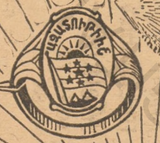Auctioned Postcard Reveals the First Ever Photograph of an Armenian Seven-Starred Flag
- Leo Torosian

- Feb 15
- 3 min read
This week, I made the acquisition of this pre-1918 postcard, made in Richmond, Virginia, depicting an Armenian man seated in front of three flags. One of the flags appears to be a never-before photographed seven-starred variant of the Armenian flag.

An initial analysis of this unknown photograph reveals more details:

On the right is an American 48-star flag, used in the United States between 1912 and 1959, and pictured in many Armenian Diaspora photographs from that era. Displaying one’s allegiance was of utmost importance in early 20th-century America.

In the center, an Armenian Revolutionary Federation banner, certainly painted on fabric and locally-made, makes allusion to a common Armenian Relief Society symbol, the Cross. It is possible that the Cross was red and the banner was white, similar to the Musa Dagh flag. The ARS-style cross emphasizes the importance of the ARF’s mandate to provide relief through its sister organizations.

The flag on the left is the most intriguing out of the three. The color scheme was possibly red-white-green, as was popular between the 1890s and the 1910s to represent Armenian flags. The flag’s middle band depicts 7 stars, a staple of the “liberty” style design of the era. The star in the middle represents Armenian Cilicia and the six stars surrounding it represent the six Armenian Vilayets (provinces) of the Ottoman Empire.
It is yet unclear when the 7-star layout emerged but we do have evidence of a 7-star flag having been popular in the 1910’s and being flown during the 1920 British-occupation of Cilicia.
In Kazanjian’s The Cilician Armenian Ordeal, Avedis Seferian recounts:
"My brother wanted to return [to Marash] with his family. I was not in favor. A number of half-baked politicians from Marash wanted to have a flag prepared and march back into the city with the flag waving."
"They began to solicit contributions. I refused to be involved. I argued that it was premature to talk about a flag, that the Armenian question was first to be sealed at the Allied peace conference. If the decision was favorable, then we could begin to prepare our flag. But these ignorant persons collected 64 Turkish pounds and prepared a tricolor flag on which were embroidered in gold six stars representing the six Armenian vilayets (the provinces in Turkish Armenia), and one large star in the middle representing Cilicia."
"The Armenian repatriates left the Holy Cross Church, preceded by band music, the Armenian clergy, and the officials of the Arab government. When in Aleppo, the military governor prohibited the display of the flag. The group met the same fate when they reached Marash," recounts Seferian.
After the Armistice of Mudros, the British were replaced by French troops. Soon, Turkish forces militarily defeated the French and the Armenians were massacred. leaving Marash to be absorbed by the Turkish Republic.
Although this compelling story reveals many details regarding this lost symbol, the seven-starred flag appears to have been rarely photographed. In fact, prior to my acquisition of this postcard, I had not come across any photographic evidence of this flag design. However, drawings of this flag design have appeared in different publications, such as the ones below, which advertise a ring with a seven-star Armenian flag. Both ring designs incorporate the word “Ազատութիւն” [liberty], leaving no place for doubt about the meaning of the flag: a free and united Ottoman Armenia, from the Mediterranean sea to the Russian border.
Sources:
Kazanjian, Paren. The Cilician Armenian Ordeal. Hye Intentions, 1989.
Hairenik Archives
Demoyan, Hayk. Armenian Legacy in America: A 400-year Heritage, Aurora Humanitarian Initiative, 2018.











Kommentare